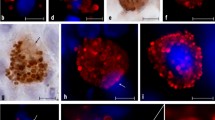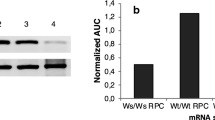Abstract
Increased infiltration of the kidney by mast cells is associated with proteinuria, and interstitial fibrosis in various renal diseases. Mast cells produce serine proteases including tryptase and chymase (MCC) that act via protease-activated receptors (PARs) to induce synthesis of fibrogenic cytokines by renal cells. In the present study, we investigated direct effect of MCC and role of PARs on glomerular albumin permeability (Palb). Isolated rat glomeruli were incubated with MCC (0.1, 1, 10, and 100 ng/ml) for 5–30 min in presence or absence of PAR-1 and PAR-2 blocking antibodies. Palb was determined from the change in glomerular volume in response to an albumin oncotic gradient. The effect of direct activation of PARs on Palb was verified by incubating glomeruli with synthetic hexapeptide known to activate PAR-1 and PAR-2. MCC increased Palb of isolated rat glomeruli in a dose- and time-dependent manner. Blocking PAR-2 prevented MCC-mediated increase in Palb. RT-PCR analysis of glomerular RNA demonstrated the presence of constitutively expressed PAR-1, -2, and -3 and low levels of PAR-4. In addition, direct activation of PAR-2 by hexapeptide SLIGKV increased Palb comparable to MCC, whereas PAR-1 activation by TFLLRN had no effect on Palb. Our results document that MCC induces increase in Palb and that this effect is mediated through PAR-2. MCC may also play a role in renal scarring. We propose that inhibiting MCC activity or blocking the activation of PAR-2 may provide new targets for therapy in renal diseases.
Similar content being viewed by others
Abbreviations
- MCC:
-
mast cell chymase
- PARs:
-
protease-activated receptors
- Palb :
-
glomerular albumin permeability
References
Galli SJ New concepts about the mast cell. N Eng J Med 328: 257–265, 1993
Eddy AA Mast cells find their way to the kidney. Kidney Int 60: 375–377, 2001
Ehara T, Shigematsu H Mast cells in the kidney. Nephrol 8: 130–138, 2003
Danilewicz M, Wagrowska-Danilewicz M Quantitative analysis of the interstitial mast cells in idiopathic mesangiocapillary glomerulonephritis type I. Nefrologia 21: 253–259, 2001
Hiromura K, Kurosawa M, Yano S, Naruse T Tubulointerstitial mast cell infiltration in glomerulonephritis. Am J Kidney Dis 32: 593–599, 1998
Ehara T, Shigematsu H Contribution of mast cells to the tubulointerstitial lesions in IgA nephritis. Kidney Int 54: 1675–1683, 1998
Ritz E. Chymase: a potential culprit in diabetic nephropathy? J Am Soc Nephrol 14: 1952–1954, 2003
Ruger BM, Hasan Q, Greenhill NS, Davis PF, Dunbar PR, Neale TJ Mast cells and type VIII collagen in human diabetic nephropathy. Diabetologia 39:1215–1222, 1996
Kondo S, Kagami S, Kido H, Strutz F, Muller GA, Kuroda Y Role of mast cell tryptase in renal interstitial fibrosis. J Am Soc Nephrol 12: 1668–1676, 2001
Roberts ISD, Brenchley PEC Mast cells: the forgotten cells of renal fibrosis. J Clin Pathol 53: 858–862, 2000
Lajoie G, Nadasdy T, Laszik Z, Blick KE, Silva FG Mast cells in acute cellular rejection of human renal allografts. Mod Pathol 12: 1118–1125, 1996
Hochegger K, Siebenhaar F, Vielhauer V, Heininger D, Mayadas TN, Mayer G, Maurer M, Rosenkranz AR Role of mast cells in experimental anti-glomerular basement membrane glomerulonephritis. Eur J Immunol 35: 3074–3082, 2005
Timoshanko JR, Kitching R, Semple TJ, Tipping PG, Holdsworth SR A pathogenetic role for mast cells in experimental crescentic glomerulonephritis. J Am Soc Nephrol 17: 150–159, 2006
Jones SE, Kelly DJ, Cox AJ, Zhang Y, Gow RM, Gilbert RE Mast cell infiltration and chemokine expression in progressive renal disease. Kidney Int 64: 906–913, 2003
Kahn ML, Zheng YW, Huang W, Bigornia V, Zeng D, Moff S, Farese RV Jr., Tam C, Coughlin SR A dual thrombin receptor system for platelet activation. Nature 394: 690–694, 1998
Ny M, Barnathan M, Numerof ES, Clark J, Dreyer M, Cumashi A, Hoxie JA, Schechter N, Woolkalis M, Brass LF Interaction of mast cell tryptase with thrombin receptors and PAR-2. J Bio Chem 272: 4043–4049, 1997
Cenac N, Chin AC, Garcia-Villar R, Salvador-Cartier C, Ferrier L, Vergnolle N, Buret AG, Fioramonti J, Bueno L PAR2 activation alters colonic paracellular permeability in mice via IFN-gamma-dependent and independent pathways. J Physiol 558: 913–925, 2004
Miyata S, Koshikawa N, Yasumitsu H, Miyazaki K Trypsin stimulates integrin α5ß1-dependent adhesion to fibronectin and proliferation of human gastric carcinoma cells through activation of PAR-2. J Biol Chem 275: 4592–4598, 2000
Yamada M, Ueda M, Naruko T, Tanabe S, Han YS, Ikura Y, Ogami M, Takai S, Miyazaki M Mast cell chymase expression and mast cell phenotypes in human rejected kidneys. Kidney Int 59: 1374–1381, 2001
Huang XR, Chen WY, Truong LD, Lan HY Chymase is up-regulated in diabetic nephropathy: implications for an alternative pathway of angiotensin II-mediated diabetic renal and vascular disease. J Am Soc Nephrol 14: 1738–1747, 2003
Sharma R, Sharma M, Khanna AK, Savin VJ Transforming Growth factor increases glomerular albumin permeability via hydroxyl radicals. Kidney Int 58: 131–136, 2000
McCarthy ET, Sharma R, Sharma M, Li JZ, Ge X, Dileepan KN, Savin VJ Tumor necrosis factor-a increases albumin permeability of isolated rat glomeruli through the generation of superoxide. J Am Soc Nephrol 9: 433–438, 1998
Sharma R, Suzuki K, Nagase H, Savin VJ Matrix metalloproteinase (Stromelysin-1) increases glomerular albumin permeability of isolated rat glomeruli. J Lab Clin Med 129: 297–303, 1996
Li JZ, Sharma R, Dileepan KN, Savin VJ Polymorphonuclear leukocytes increase albumin permeability via hypohalous acid. Kidney Int 46: 1025–1030, 1994
McCarthy ET, Sharma R, Sharma M Protective effect of 20-hydroxyeicosatetraenoic acid (20-HETE) on glomerular protein permeability barrier. Kidney Int 67: 152–156, 2005
Dahly-Vernon AJ, Sharma M, McCarthy ET, Savin VJ, Ledbetter SR, Roman RJ Transforming growth factor-beta, 20-HETE interaction, and glomerular injury in Dahl salt-sensitive rats. Hypertension 45: 643–648, 2005
Savin VJ, Sharma R, Lovell HB, Welling DJ Measurement of albumin reflection coefficient with isolated rat glomeruli. J Am Soc Nephrol 3: 1260–1269, 1992
Nickel TJ, Kabir MH, Talreja J, Stechschulte DJ, Dileepan KN Constitutive expression of functionally active protease-activated receptors 1 and 2 in human conjunctival epithelial cells. Mediators of Inflammation Volume 2006 Article Id 61359, 8 Pages, 2006
Chi L, Li Y, Stehno-Bittel L, Gao J, Morrison DC, Stechschulte DJ, Dileepan KN Interleukin-6 production by endothelial cells via stimulation of protease-activated receptors is amplified by endotoxin and tumor necrosis factor-alpha. J Interferon Cytokine Res 21: 231–240, 2001
Rangan GK, Harris DC A blast from the mast? Kidney Int 64: 1134–1135, 2003
Church MK, Levi-Schaffer F The human mast cell: updates on cells and cytokines. J Allergy Clin Immunol 99: 155–160, 1997
Kondo S, Kagami S, Kido H, Strutz F, Müller GA, Kuroda Y Role of mast cell tryptase in renal interstitial fibrosis. J Am Soc Nephrol 12: 1668–1676, 2001
Reiling KK, Krucinski J, Miercke LJ, Raymond WW, Caughey GH, Stroud RM Structure of human pro-chymase. A model for the activating transition of granule-associated proteases. Biochemistry 42: 2616–2624, 2003
Miyazaki M, Takai S Local angiotensin II-generating system in vascular tissues: the roles of chymase. Hypertens Res 24: 189–193, 2001
Okunishi H, Oka Y, Shiota N, Kawamoto T, Song K, Miyazaki M Marked species-difference in the vascular angiotensin II-forming pathways: human versus rodents. Jpn J Pharmacol 62: 207–210, 1993
Fang KC, Raymond WW, Blount JL, Caughey GH Dog mast cell alpha-chymase activates progelatinase B by cleaving the Phe88-Gln89 and Phe91-Glu92 bonds of the catalytic domain. J Biol Chem 272: 25628–25635, 1997
Murakami M, Matsuda H, Kubota E, Wakino S, Honda M, Hayashi Saruta T Role of angiotensin II generated by angiotensin converting enzyme-independent pathways in canine kidney. Kidney Int 63: S13–S15, 1997
Tokuyama H, Hayashi K, Matsuda H, Kubota E, Honda M, Okubo K, Takamatsu I, Tatematsu S, Ozawa Y, Wakino S, Saruta T Differential regulation of elevated renal angiotensin II in chronic renal ischemia. Hypertension 40: 34–40, 2002
Inui D, Yoshizumi M, Suzaki Y, Kirima K, Tsuchiya K, Houchi H, Kagami S, Tamaki T Effect of endothelin-1(131) on p38 mitogen-activated protein kinase in cultured human mesangial cells. Life Sci 68: 635–645, 2000
Hollenberg MD, Wijesuriya SJ, Gui Yu, Loutzenhiser R Proteinases-activating receptors (PARS) and the kidney. Drug Dev Res 60: 36–42, 2003
Nystedt S, Emilsson K, Wahlestedt C, Sundelin J Molecular cloning of a potential proteinase activated receptor. Proc Natl Acad Sci 91: 9208–9212, 1994
Ishihara H, Connolly AJ, Zeng D, Kahn ML, Zheng YW, Timmons C, Tram T, Coughlin SR Protease-activated receptor 3 is a second thrombin receptor in humans. Nature 386: 502–506, 1997
Xu WF, Andersen H, Whitmore TE, Presnell SR, Yee DP, Ching A, Gilbert T, Davie EW, Foster DC Cloning and characterization of human protease-activated receptor 4. Proc Natl Acad Sci 95: 6642–6646, 1998
Grandaliano G, Pontrelli P, Cerullo G, Monno R, Ranieri E, Ursi M, Loverre A, Gesualdo L, Schena FP PAR-2 expression in IgA nephropathy: a potential role in the pathogenesis of interstitial fibrosis. J Am Soc Nephrol 8: 2072–2083, 2003
Bertog M, Letz B, Kong W, Steinhoff M, Higgins MA, Bielfeld-Ackermann A, Fromter E, Bunnett NW, Korbmacher C Basolateral proteinase-activated receptor (PAR-2) induces chloride secretion in M-1 mouse renal cortical collecting duct cells. J Physiol 52: 3–17, 1999
Déry O., Corvera CU, Steinhoff M, Bunnett NW Proteinase-activated receptors: novel mechanisms of signaling by serine proteases. Am J Physiol 274: C1429–C1452, 1998
Vu TK, Hung HDT, Wheaton VI, Coughlin SR Molecular cloning of a functional thrombin receptor reveals a novel proteolytic mechanism of receptor activation. Cell 64: 1057–1068, 1991
Edwards A, Daniels BS, Deen WM Ultrastructural model for size selectivity in glomerular filtration. Am J Physiol 276: F892–F902, 1999
Adler S, Sharma R, Savin VJ, Abbi R, Eng B Alteration of glomerular permeability to macromolecules induced by cross-linking of β1-integrin receptors. Am J Pathol 149: 987–996, 1996
Sharma M, McCarthy ET, Sharma R, Fish B, Savin VJ, Cohen E, Moulder J Arachidonic acid metabolites mediate the radiation-induced increase in glomerular albumin permeability. Exp Biol Med 231: 99–106, 2006
Acknowledgments
This work was supported by funds from the Midwest Biomedical Research Foundation, Kansas City, MO (Ram Sharma) and NIH/NIDDK RO1 DK 064969 (Ellen T. McCarthy). Portions of these data have been presented at the 39th Annual Meetings of the American Society of Nephrology (November 5–8, 2006, San Diego, CA).
Author information
Authors and Affiliations
Corresponding author
Rights and permissions
About this article
Cite this article
Sharma, R., Prasad, V., McCarthy, E.T. et al. Chymase increases glomerular albumin permeability via protease-activated receptor-2. Mol Cell Biochem 297, 161–169 (2007). https://doi.org/10.1007/s11010-006-9342-0
Received:
Accepted:
Published:
Issue Date:
DOI: https://doi.org/10.1007/s11010-006-9342-0




